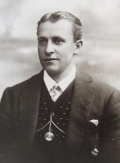Australian vaudeville comedian, minstrel endman, singer.
Arguably Harry Clay's longest-serving performer and most popular comedian, Ted Tutty also secured engagements with almost every other major variety organisation in Australia between 1905 and 1925, including Fullers Theatres, Harry Rickards and the later Tivoli circuit, Bert Howard, J.C. Bain, Harry Sadler, Frank Reis, Dix-Baker (Newcastle) and Jacky Landow. It was through his association with Harry Clay's company, however (which included seven Queensland tours, in 1905-1907, 1909-1910, 1913, and 1915) that his reputation was largely built. In this respect, Tutty was viewed by his peers as being as important to Harry Clay as Will Whitburn and Pope and Sayles (Charlie Pope and Irving Sayles) were to Harry Rickards. Tutty was also an important influence on emerging artists during the late 1910s and early 1920s, with Roy Rene being one performer to acknowledge a debt of gratitude (Mo's Memoirs, pp.52-55).
Often referred to as 'the simple chap' or the 'tired comedian', Tutty was an institution with Clay's Newtown audiences. Although his forte was as a solo comedian, he did work in partnership with other comedians during his career, including his wife Kate Cahill (better known to audiences as Muriel Eskbank). The couple married at Port Pierre (South Australia) in 1902. Tutty's name has been located in a advertised bill as early as 1900, for his debut engagement with the People's Concerts in Melbourne (22 September). He has also been identifed as performing in Wellington, New Zealand, in 1903, as a member of Fullers' Entertainers.
Tutty briefly attempted a managerial career in 1916, touring his own company through NSW and presenting entertainment at the Daceyville Theatre in Sydney. Competition by this time had grown fierce throughout Australia, due to marked expansion within the industry, and Tutty's position as one of the country's leading comedians saw him eventually return to the stage as a performer. He returned to management in late 1918 or early 1919, but was again forced to abandon this career, this time in response to the Spanish influenza epidemic.
Tutty continued working for Clay up until the entrepreneur's death in 1925, while also undertaking occasional engagements with other firms. During the 1920s, he also worked up an act with his two daughters. Following the demise of vaudeville in the late 1920s, however, Tutty's career wound down, and by the late 1930s he had all but retired from full-time entertaining. One of his last-known professional engagements was the 1940 Tivoli Anniversary Show. During his final years, he blacked up in minstrel makeup for occasional one-off shows, including a night at Sammy Lee's Theatre Restaurant (Sydney) shortly before his death.
